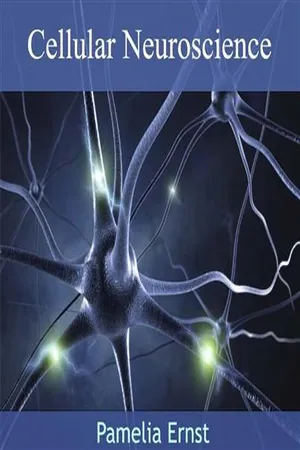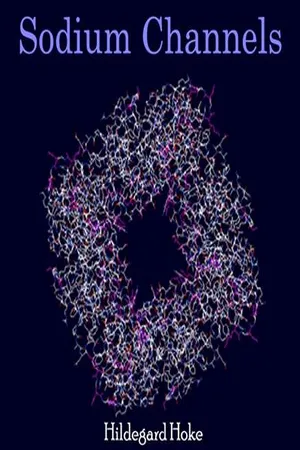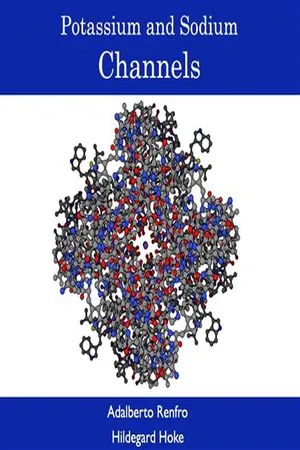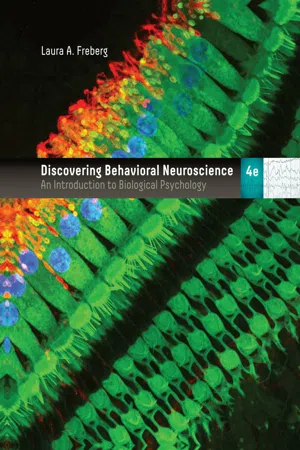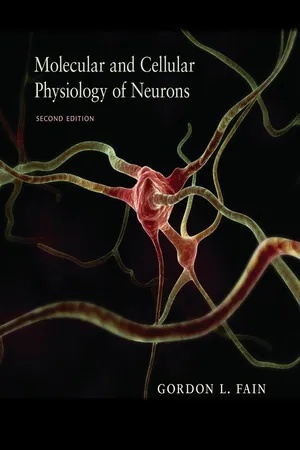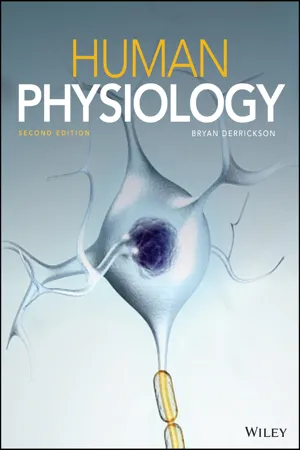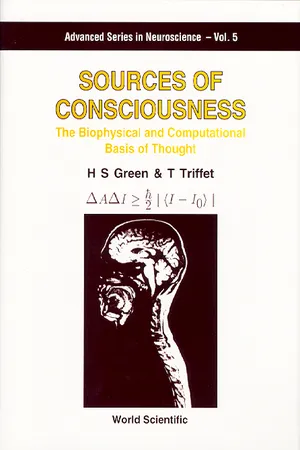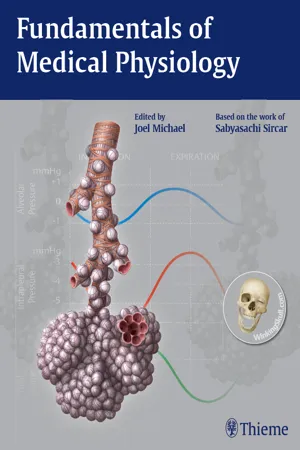Biological Sciences
Action Potential
An action potential is a brief electrical impulse that travels along the membrane of a neuron or muscle cell. It is generated by the movement of ions across the cell membrane, resulting in a rapid change in membrane potential. This process is essential for communication within the nervous system and muscle contraction.
Written by Perlego with AI-assistance
Related key terms
1 of 5
11 Key excerpts on "Action Potential"
- No longer available |Learn more
- (Author)
- 2014(Publication Date)
- Research World(Publisher)
________________________ WORLD TECHNOLOGIES ________________________ Chapter- 10 Action Potential In physiology, an Action Potential is a short-lasting event in which the electrical membrane potential of a cell rapidly rises and falls, following a stereotyped trajectory. Action Potentials occur in several types of animal cells, called excitable cells, which include neurons, muscle cells, and endocrine cells, as well as in some plant cells. In neurons, they play a central role in cell-to-cell communication. In other types of cells, their main function is to activate intracellular processes. In muscle cells, for example, an Action Potential is the first step in the chain of events leading to contraction. In beta cells of the pancreas, they provoke release of insulin. Action Potentials in neurons are also known as nerve impulses or spikes, and the temporal sequence of Action Potentials generated by a neuron is called its spike train. A neuron that emits an Action Potential is often said to fire. Action Potentials are generated by special types of voltage-gated ion channels embedded in a cell's plasma membrane. These channels are shut when the membrane potential is near the resting potential of the cell, but they rapidly begin to open if the membrane potential increases to a precisely defined threshold value. When the channels open, they allow an inward flow of sodium ions, which changes the electrochemical gradient, which in turn produces a further rise in the membrane potential. This then causes more channels to open, producing a greater electric current, and so on. The process proceeds explosively until all of the available ion channels are open, resulting in a large upswing in the membrane potential. The rapid influx of sodium ions causes the polarity of the plasma membrane to reverse, and the ion channels then rapidly inactivate. As the sodium channels close, sodium ions can no longer enter the neuron, and they are actively transported out of the plasma membrane. - No longer available |Learn more
- (Author)
- 2014(Publication Date)
- Library Press(Publisher)
____________________ WORLD TECHNOLOGIES ____________________ Chapter- 2 Action Potential An Action Potential is a short-lasting event in which the electrical membrane potential of a cell rapi dly rises and falls, following a consistent trajectory. Action Potentials occur in several types of animal cells, called excitable cells, which include neurons, muscle cells, and endocrine cells, as well as in some plant cells. In neurons, they play a cent ral role in cell-to-cell communication. In other types of cells, their main function is to activate intracellular processes. In muscle cells, for example, an Action Potential is the first step in the chain of events leading to contraction. In beta cells of the pancreas, they provoke release of insulin. Action Potentials in neurons are also known as nerve impulses or spikes, and the temporal sequence of Action Potentials generated by a neuron is called its spike train. A neuron that emits an Action Potential is often said to fire. Action Potentials are generated by special types of voltage-gated ion channels embedded in a cell's plasma membrane. These channels are shut when the membrane potential is near the resting potential of the cell, but they rapidly begin to open if the membrane potential increases to a precisely defined threshold value. When the channels open, they allow an inward flow of sodium ions, which changes the electrochemical gradient, which in turn produces a further rise in the membrane potential. This then causes more channels to open, producing a greater electric current, and so on. The process proceeds explosively until all of the available ion channels are open, resulting in a large upswing in the membrane potential. The rapid influx of sodium ions causes the polarity of the plasma membrane to reverse, and the ion channels then rapidly inactivate. As the sodium channels close, sodium ions can no longer enter the neuron, and they are actively transported out of the plasma membrane. - eBook - PDF
- Joseph D. Bronzino, Donald R. Peterson(Authors)
- 2014(Publication Date)
- CRC Press(Publisher)
These Action Potentials are pulse-like changes of the transmembrane potential, the voltage difference across the nerve membrane (defined as potential inside minus the potential outside) In nerves, action poten-tials involve a voltage change of about 100 mV for a duration of about 3 ms The energy required to produce each Action Potential comes mostly from energy stored across the membrane at that site The succession of Action Potentials down the nerve fiber occurs because the Action Potential in each V m Time (a) Stimulation (b) Propagation (c) Contraction Probe J uni03B8 Action potent ials FIGURE 38.2 A modern Galvani-like experiment An experiment similar to that of Galvani is sketched, shows a probe (a) that creates current density J around the tip The current causes Action Potentials (b) to occur in the nerve The Action Potentials are drawn with stylized triangular waveforms, offset horizontally to suggest the time delay arising from Action Potentials propagating along the nerve Symbol θ represents the conduction velocity, usually 1 m/s or more ( θ is used in electrophysiology to be different from voltage V ) Neurotransmitters (indicated by small circles at (c) allow the neural excitatory signal to cross into the muscle Action Potentials in the muscle release cal-cium ions, which leads to muscle contraction FIGURE 38.1 Galvani experiment This historical drawing shows a probe touching a frog The leg, originally extended, contracts (lighter sketch) due to the electrical shock - No longer available |Learn more
- (Author)
- 2014(Publication Date)
- College Publishing House(Publisher)
Action Potentials from the AV node travel through the bundle of His and thence to the Purkinje fibers. Conversely, anomalies in the cardiac Action Potential—whether due to a congenital mutation or injury—can lead to human ____________________ WORLD TECHNOLOGIES ____________________ pathologies, especially arrhythmias. Several anti-arrhythmia drugs act on the cardiac Action Potential, such as quinidine, lidocaine, beta blockers, and verapamil. Muscular Action Potentials The Action Potential in a normal skeletal muscle cell is similar to the Action Potential in neurons. Action Potentials result from the depolarization of the cell membrane (the sarcolemma), which opens voltage-sensitive sodium channels; these become inactivated and the membrane is repolarized through the outward current of potassium ions. The re sting potential prior to the Action Potential is typically −90mV, somewhat more negative than typical neurons. The muscle Action Potential lasts roughly 2–4 ms, the absolute refractory period is roughly 1–3 ms, and the conduction velocity along the muscle is roughly 5 m/s. The Action Potential releases calcium ions that free up the tropomyosin and allow the muscle to contract. Muscle Action Potentials are provoked by the arrival of a pre-synaptic neuronal Action Potential at the neuromuscular junction, which is a common target for neurotoxins. Plant Action Potentials Plant and fungal cells are also electrically excitable. The fundamental difference to animal Action Potentials is, that the depolarization in plant cells is not accomplished by an uptake of positive sodium ions, but by release of negative chloride ions. Together with the following release of positive potassium ions, which is common to plant and animal Action Potentials, the Action Potential in plants infers, therefore, an osmotic loss of salt (KCl), whereas the animal Action Potential is osmotically neutral, when equal amounts of entering sodium and leaving potassium cancel each other osmotically. - eBook - PDF
- Sverre Grimnes, Orjan G. Martinsen(Authors)
- 2011(Publication Date)
- Academic Press(Publisher)
139 EXCITABLE TISSUE AND BIOELECTRIC SIGNALS 5 Chapter Contents 5.1 Cell Polarization 5.2 Action Potential 5.2.1 Ion Channels 5.2.2 Channel Gating 5.2.3 Cell Potential Model 5.2.4 Cell Oscillator 5.3 The Neuron 5.3.1 Motor Neuron 5.3.2 Brain and Neurons 5.4 Axon Transmission 5.4.1 Excitation from the Soma 5.4.2 Exogenic Excitation 5.4.3 Moving Current Dipole 5.4.4 Myelinated Axons 5.4.5 The Nerve 5.4.6 Synapses 5.4.7 Excitation 5.4.8 External Current Excitation 5.5 Receptors 5.5.1 Patch Clamp Technique Problems In living tissue important communication control is implemented by hormones and nerves. Hormones are slow broadcasting information carriers; nerves are quick pre-wired point-to-point information carriers. Some cells are not excitable, for instance the cells of adipose and connective tissue or blood. They are passive, not under nerve control, and only weakly polarized. However, nerve, muscle and gland 140 CHAPTER 5 EXCITABLE TISSUE AND BIOELECTRIC SIGNALS cells are polarized and excitable; within a 1/1000 second such cells may react on trigger signals such as electrical, mechanical or chemical energy. The excitation of a cell is accompanied by an Action Potential . The Action Potential is the basic bioelec-tric event and signal source in the body. In Section 4.1.4 the passive cell membrane was described. The membrane is a bilayer lipid membrane (BLM) shown in Figs. 4.6 and 5.1. The membrane of a liv-ing cell is a most complex and dynamic system. The cell membrane itself is a major barrier to ion flux, but embedded in the membrane are channels, transporters and ion pumps . Electrically, they represent shunt pathways in parallel with the BLM (Figs 5.1 and 5.3). The water channels are a special class of channels selectively allowing water flux (but without electric charge: no proton, no ion flux) in response to osmotic gradients and therefore regulating cell volume swelling or shrinking. - eBook - PDF
Discovering Behavioral Neuroscience
An Introduction to Biological Psychology
- Laura Freberg(Author)
- 2018(Publication Date)
- Cengage Learning EMEA(Publisher)
Copyright 2019 Cengage Learning. All Rights Reserved. May not be copied, scanned, or duplicated, in whole or in part. Due to electronic rights, some third party content may be suppressed from the eBook and/or eChapter(s). Editorial review has deemed that any suppressed content does not materially affect the overall learning experience. Cengage Learning reserves the right to remove additional content at any time if subsequent rights restrictions require it. CHAPTER 3 Neurophysiology: The Structure and Functions of the Cells of the Nervous System 94 Summary Points 1. The intracellular fluid contains large amounts of potassium and smaller amounts of sodium and chloride. The extracellular fluid contains large amounts of sodium and chloride and smaller amounts of potassium. (LO5) 2. The resting potential of neurons averages about −70mV. In other words, the interior of the cell is negatively charged relative to the exterior. An Action Potential is a reversal of this polarity. (LO5) 3. Absolute and relative refractory periods, during which further Action Potentials are either impossible or less likely, result from the nature of the sodium and potassium channels. (LO5) 4. Action Potentials move much more rapidly down the length of myelinated axons than in unmyelinated axons due to the process of saltatory conduction. (LO5) Review Questions 1. How do diffusion and electrostatic pressure account for the chemical composition of intracellular and extracellular fluids when the neuron is at rest? 2. How do neurons signal stimulus intensity given that the Action Potential is all-or-none? ● Figure 3.19 Neurons Communicate at the Synapse This colored electron micrograph shows the axon terminals from many neurons forming synapses on a cell body. OMIKRON/Science Source The Synapse The birth and propagation of the Action Potential within the presynaptic neuron makes up the first half of our story of neural communication. - eBook - PDF
Molecular and Cellular Physiology of Neurons
Second Edition
- Gordon L. Fain, Margery J. Fain(Authors)
- 2015(Publication Date)
- Harvard University Press(Publisher)
PART TWO Active Propagation of Neural Signals The passive spread or decremental conduction of electrical sig-nals down the axons and dendrites of nerve cells described in Chap-ter 2 is one way messages can be communicated from one part of the nervous system to another. Passive spread is essential for the conveyance of synaptic potentials within the dendritic tree, and some neurons (like the starburst amacrine cell of Plate Fig. 2.2) ap-pear to use only decremental conduction to transmit electrical sig-nals. These cells are probably exceptions. Many neurons in the CNS are too large to be able to rely only on passive spread. Pyramidal cells can have long axons that convey signals from the brain to the spinal cord. Some other mechanism must exist for the reliable trans-mission of electrical signals over such extended distances. This mechanism is active propagation mediated by action poten-tials, which are also called spikes. An Action Potential is a large, re-generative depolarization produced by voltage-gated channels. In an axon, spikes are initiated by a depolarization of the membrane— for example, from excitatory synaptic input. This depolarization facilitates a change in conformation of proteins called voltage- gated Na + channels , leading to the opening of a pore selective for Na + (Fig. 5.1A). As Na + channels open, the relative permeability of the membrane to Na + increases and the membrane depolarizes, be-cause the membrane potential (ignoring Cl − ) is given by V m = RT F ln α [Na + ] o + [K + ] o α [Na + ] i + [K + ] i (3.38) where α = P Na /P K . When the external Na + concentration is larger than the internal Na + concentration, any increase in P Na will produce a positive change in membrane potential. 5 Action Potentials: The Hodgkin-Huxley Experiments 146 ACTIVE PROPAGATION OF NEURAL SIGNALS Fig. 5.1 Action Potentials. - eBook - PDF
- Bryan H. Derrickson(Author)
- 2019(Publication Date)
- Wiley(Publisher)
Action Potentials Undergo Propagation To communicate information from one part of the body to another, Action Potentials in a neuron must travel from the trigger zone of the axon (their point of origin) to the axon terminals. In contrast to a graded potential, an Action Potential is not decre- mental (it does not die out). Instead, an Action Potential main- tains its strength as its spreads along the membrane. This mode of conduction, called propagation, depends on positive feed- back. When sodium ions flow in, they cause voltage-gated Na + channels in adjacent segments of the membrane to open. Thus, the Action Potential travels along the membrane rather like the activity of that long row of dominoes. The propagation of an Action Potential is accomplished by local current flow (see Fig- ure 7.17). Recall that local current flow refers to the passive movement of charges from one membrane region to adjacent membrane regions due to differences in membrane potential in these areas. In a neuron, an Action Potential can propagate along the axon away from the cell body only—it cannot propagate back toward the cell body because any region of membrane that has just undergone an Action Potential is temporarily in the absolute refractory period and cannot generate another Action Potential. You should realize that it is not the same Action Potential that propagates along the entire axon. Rather, the Action Potential regenerates over and over at adjacent regions of membrane from the trigger zone to the axon terminals (Figure 7.23). Regeneration of the Action Potential along an unmyelinated axon of a neuron is similar to the “wave” that is performed by fans at a football game. Like the Action Potential, the wave is regenerated throughout the stadium as each fan sequentially stands up (the depolarizing phase of the Action Potential) and then sits down (the repolariz- ing phase of the Action Potential). Therefore, it is the wave that travels around the stadium, not the actual fans. - eBook - PDF
Sources Of Consciousness: The Biophysical And Computational Basis Of Thought
The Biophysical and Computational Basis of Thought
- Herbert Sydney Green, Terry T Triffet(Authors)
- 1997(Publication Date)
- World Scientific(Publisher)
The internal electric potential of such a cell is normally of the order of 50-100 mV (millivolts) below that of the extracellular fluid. Graded potentials are fluctuations of a few mV in the internal potential within the cell, in the course of which the cell is said to be potentiated. Under conditions that we shall study in detail in subsequent chapters they may develop into firings, or Action Potentials, during which the internal potential rises briefly to a level that may exceed the potential outside the cell. As these potentials and associated potential waves IN: 1.4 REAL AND ARTIFICIAL NEURAL NETS 17 in the extracellular fluid constitute the primary means by which infor-mation is transferred throughout the nervous system, their properties may be expected to strongly influence, if not fully determine, all higher processes. rs Fig. 1.1: Time variation of the electrical potential (mV) in the axon hillock of a typical neuron subjected, first, to a current pulse that does not cause this potential to exceed the threshold T (-65 mV) of the neuron, but produces a graded potential; and next, to a slightly larger pulse that causes the potential to exceed T and produce an Action Potential, followed by an insensitive refractory state. In the vertebrates, a typical neuron consists of a soma, or cell body, an axon, or fibre that transmits potentials to the synapses where it communicates with other neurons, and dendrites which receive infor-mation from other neurons. The action of a cell is determined chiefly by the value of the potential at the hillock near where the axon leaves the body of the cell, and an Action Potential is possible only if this potential exceeds a certain threshold value. This is illustrated by the typical potential within a firing neuron, shown in Figure 1.1. The in-formation that the neuron can transfer depends on the frequency of its firing peaks. In the following Chapter we shall discuss the way in which - eBook - PDF
- Joel Michael, Sabyasachi Sircar(Authors)
- 2011(Publication Date)
- Thieme(Publisher)
When this polar-ity is briefly reversed, it serves as a signal that is conducted over long distances along the nerve membrane. This signal is called the Action Potential (AP). However, before discussing the Action Potential (Chapter 7) or its conduction over the nerve membrane (Chapter 13), it is necessary to understand the origin of the rest-ing membrane potential. This is discussed below in detail. It is important to point out that muscle cells, too, have a rest-ing membrane potential, and that it originates from the same mechanisms as are seen in nerve cells and described below. Furthermore, changes to the resting membrane potential in muscle serve the same function as they do in nerve cells. Finally, it should be remembered that all cells, even those for which information processing is not an important function, exhibit a resting potential. Diffusion Potential The inner surface of a cell membrane is usually charged neg-ative with respect to its outer surface ( Fig. 6.1 ). The poten-tial of the inner surface of the membrane with respect to its outer surface is called the membrane potential. The potential is called a membrane potential because it exists essentially on the membrane. The cations and anions form layers on the outer and inner membrane surfaces, respectively. The mem-brane potential is produced by the passive diffusion of ions across the membrane. Hence, it is also called a diffusion potential. The membrane potential changes markedly when the mem-brane is electrically stimulated (when an electrical current is made to flow across the membrane, whether artificially in the laboratory or by a physiologic process). The potential recorded intracellularly when a cell is not stimulated is called the rest-ing membrane potential (RMP), and the membrane is said to be polarized. The unmyelinated axonal membrane has an RMP of –70 mV. The membrane potential is more negative (–90 mV) in striated muscles and less negative (–50 mV) in certain smooth muscles. - eBook - PDF
- George Spilich(Author)
- 2023(Publication Date)
- Wiley(Publisher)
Dam a. b. GYRO PHOTOGRAPHY/amanaimagesRF/Getty Images Potential energy Kinetic energy Water pressure 2.3 Neural Transmission of a Signal 39 negative electrical potential when compared with the extracellular environ- ment, which has a slightly positive electrical potential. Opposite charges attract, so there is a force acting on the axonal membrane to exchange sodium and potassium ions and thereby eliminate the difference in electri- cal potential between the inside and outside cellular environments. The magnitude of the difference between the electrical potentials inside and outside the cell is known as the membrane potential. The membrane potential is high before the neuron fires and low afterward, just as the stored energy is high at the top of the dam and much lower at the bottom. Concentration gradient In addition to the electrical potential, there is an imbalance in chemical concentrations between the internal and external environments of a neuron. The internal cellular environment has a greater concentration of potassium, whereas the external environment has a greater concentration of sodium. This difference is known as a con- centration gradient. Solutions with different chemical concentrations on either side of a semipermeable barrier will tend to equalize through diffu- sion. If you have ever placed a drop of food coloring in a glass of water and seen all the water gradually turn color, you understand the principle that fluids and gases diffuse from regions of higher concentrations to regions of lower concentrations (Figure 2.11). Similarly, there is a force acting to equalize the concentrations of sodium and potassium on either side of the axonal membrane by exchanging sodium and potassium ions. Resting potential Think back to the example of the hydroelectric dam, where the water behind the dam was a source of potential energy.
Index pages curate the most relevant extracts from our library of academic textbooks. They’ve been created using an in-house natural language model (NLM), each adding context and meaning to key research topics.
